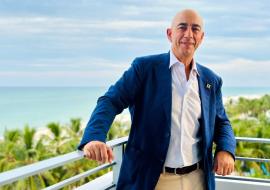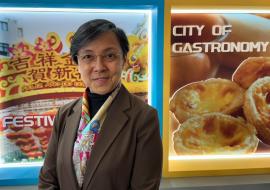Q & A with Juan Carlos Cal y Mayor, Secretary of Tourism in Chiapas, Mexico

Q & A with Juan Carlos Cal y Mayor
Secretary of Tourism in Chiapas, Mexico
By Yndiana Montes & Bill Milligan
Being Chiapas the state with the second largest indigenous population in Mexico, boasting the second most important wildlife reserve of the country and treasuring nearly half of the biodiversity of the whole Republic in addition to archeological wonders, are three very particular factors contributing to the fame of this tourism destination. It has been precisely this appealing combination of ancestral heritages and its overwhelming nature what won it the coveted venue of the “Adventure Travel World Summit” to take place from October 17-20 this year.
That’s the opinion of Tourism Secretary of Chiapas, Juan Carlos Cal y Mayor, who confirmed that the destination has made a serious bet on ecotourism and sustainable tourism, with the mere purpose of protecting their natural resources. We spoke with him on a Saturday morning, just at the beginning of our trip in his own house located in the busy avenue of Tuxtla Gutierrez; we sat in the patio with leafy trees and noisy parrots that made us pick up our ears to get to listen to him better.
“We have taken a lot of effort to maintain intact everything that is our heritage in a key moment when people are getting tired of the sun, sand and beach. Here we find, for example, the Lacandon community, who own the land where they live and who we have provided with everything needed to develop tourism and so they can live on that. They are increasingly attracting the attention of the world as some regard them as the missing link with the Maya World, and we support them in the preservation of their thousand-year-old customs. This world forum will be a once-in-a-lifetime opportunity to show off what we have done here in Chiapas over the last 10 years. The Lacandon Jungle stretches to 1 million hectares and the lacandones, despite being part of the western world, continue to be unshaken in their customs, rituals, attires and costumes dating back to many centuries ago. Where they live belongs to them and their families and together with them we have worked in designing and implementing a route through ecotourism sites,” the tourism authority explained.
Are those ecotourism sites managed by themselves?
-Yes, of course. We have invested in the construction and refurbishment of facilities, cottages, lodges, but also in training. They are endorsed by the Secretary of Tourism, which is a huge step to show the quality in every aspect. You don’t want to deal with poor-quality services and get to a room that is too basic when you return all muddy and tired from walking through the jungle and going up and down mountains, right? There’s where a good bed with six or eight pillows is appreciated, as well as a nice gourmet dinner with all the elements of the regional cuisine nicely presented and served; that’s where we are heading to, because we believe that warmth is not enough, there has to be quality. Warmth and quality are an unbeatable formula and in our opinion the two characteristics have to come together in order to achieve a five-star tourism. We have here gourmet chefs who prepare dishes with the typical ingredients of Chiapas capable of pleasing the most refine tastes. We are doing the same thing with textiles because the idea is to offer not only the wonderful items for sale in the markets, but also pieces of clothing that are so nice as to wear for a wedding or an Yndiana cocktail party; or leather goods that could compete with Coach products.
That is, Chiapas for all tastes and pockets, nice! Because of its history and geographical position, it was discovered many centuries ago by visitors who appreciated the natural. Today, as we all know, this is a niche market on expansion for the wealthiest too. In addition to comfort and nice food: how are you capitalizing this and in what way security issues affect you in the eyes of international markets?
-Mexico is very big, and what happens in the north of the country doesn’t necessarily affect us here. Chiapas is geographically closer to Panama and Bogota than to Hermosillo, Sonora, for instance, and I make the comparison to show you that what happens in Panama doesn’t have to affect Guatemala, just to give you an example. We lost track of the last time we heard an alarm, a kidnapping, or a bank robbery.
They probably mentioned the topic in the meeting of secretaries of Tourism that recently took place in Campeche’s Convention Center…
-Yes, and I’m sorry to say it but my problems are not the same as those of other secretaries who do have security issues. Here you will see that you can go wherever you want to, drive at night, and stand everywhere you like… without taking any risks. We understand each country’s right and obligation to warn their people traveling on vacation over security problems; fortunately they are making less generalization and narrowing the warnings to risk areas instead of whole countries, though, of course, drug trafficking and violence does have an effect on us. I don’t agree with making campaigns saying that nothing is happening, when we actually know that something is going on. We are striving to show the world our reality in Chiapas. Three millions of Mexicans arrive every year in Chiapas and more than half a million foreign tourists, and all of them return home amazed about what they found here, how safe and tranquil the region is.
Can it be said then that Chiapas is among the top five safest states in Mexico? Campeche was said to be in the top ranking followed by Yucatan.
-Certainly yes, but we don’t like to say we are the safest in case the bad guys try to fool around. Representatives from more than sixty countries and those who have came here in armored cars realize that it is not necessary when they walk down the streets and talk to people, and get to breathe the tranquility and harmony in the air. About three years ago, Queen Margrethe of Denmark came here on a private visit, with an impressive security cordon that we little by little loosened up and in the end they realized that actually it was not necessary. She walked happily down the streets. Ambassadors, like the one from Israel, who brought the secret service with him when he first traveled to Chiapas and then on his third visit… he didn’t bring anyone!
What are the examples currently studied by the Ministry?
-We have to learn from others. The case of Colombia and its campaign: “Colombia is passion, the dangerous thing is that you’d want to stay,” for example. They have made an extraordinary job bearing fruits in the growth of tourist arrivals and investments. Turkey is another case worth highlighting: a country that was demonized from that film “Midnight Express,” has been sold as a safe and interesting destination.
And regarding niche markets?
-Taking the comparison so far, let’s take a look at Spain, where it has been worked so hard in the modernization of railroad tracks and which receives 52 millions of tourists a year… however not everyone is willing to travel on a train that takes two hours and a half from Madrid to Seville… there are some people who would rather bike or walk all the way to Santiago de Compostela, in this case on religious tourism. France and its vineyards in the south are also some of our objects of study because all of these examples of success make up the new tourism, the tourism from which something is learned, that leaves an ever-lasting memory; this is what we have in mind for Chiapas, because we know what we’ve got and what we want to develop.
And what is it that you have to develop?
-Here we had to work inwards, comfort and hygiene, and at the same time try to solve the connectivity issue. Three years ago we didn’t have the airport where you landed at, and everything was much harder because there were not nice and good roads to bring visitors to Chiapas. One problem is that we don’t have railroad tracks, but on the other hand the investment made by the government of the country over the last 10 years not only on social programs but also on tourism is praiseworthy. The training provided at the Tourism Department and the authenticity hallmark imprinted in our tourist projects makes us have all the elements to boast a unique product.
In addition to the traditional offers, the wonderful ruins of Palenque, the spectacular Drain of Chiapas de Corzo, the falls of Chiflon, San Cristóbal de las Casas… what new assets will you be boosting?
-We have been exploring, for four years, the cruise market, but different from the offers in Acapulco, Los Cabos, Cozumel, Mazatlan, etc, tourists coming to Chiapas in a cruise ship will not find a Duty Free area because there is none, nor they will go to beaches at hotels; instead we offer, for example, the Coffee Route across our thousand-year-old mountains, 2,000m high, where will find farmhouses managed by German descendants who settled here many years ago and now those houses have been turned into boutique hotels. Tourists will also visit mango and banana packing factories, and they love it because it’s something different and something real, not something made just for them. Americans have loved it.
Have you thought of retired Americans and North Americans in general?
-Pretty soon US actor Harrison Ford is coming over for the shooting of some commercials for the United States. We also have European tourists that started to come here barely without promotion and tour operators which have been sending lots of people from France, Germany, Italy, and other countries, for at least four decades. They have traditionally come here looking to learn better about live cultures, the mysticism of the region, and everything related with natives and their ancestral traditions, so it sells by itself.
We started to get into the North American market two years ago with Continental, advertising the region in part of the United States with a direct flight straight from Houston operating twice a week and which has been a success, 94% full since it was inaugurated. There is one to Tabasco as well but just for oil workers; ours is just for tourism. We see a lot of possibilities in that market, but as I said before, we are aware of the fact that it takes a lot of public relations and inviting important people from that country to feel what Chiapas is. Notice that many of them spend a month or more in Guatemala to study Spanish attracted precisely by the culture we share, however Chiapas and Guatemala used to be part of the same viceroyalty, so we are targeting the market of education and the retired, aware of the economic earnings they leave behind.
What are the people’s perspectives regarding tourism?
-We have worked a lot with natives in every way achieving their integration to the projects, and I’m telling you the demanding but nice experiences I’ve had. The situation was completely different 15 or 17 years ago, although my friends in Central America say that they would have love to have a guerrilla like Zapatista’s. In the middle of the biggest political tension there were not bloody confrontations neither so many people as in other countries, thank God! People have to recognize that Chiapas gave so much to Mexico, being poor as it was! Integration has occurred in every field: cultural, social, tourism; the country’s government has widely supported several social programs. The Governor has also done a great job, I have to say it.
At this point of the conversation, in a more relaxed tone, though with the parrots still in full swing, we asked him then if it didn’t appear to him that sub-Commander Marcos had given Chiapas a high level of publicity and he said kind of half joking: “Yes, it’s true … my boss doesn’t like me to talk a lot about it because it is obviously politics, but many discovered at the moment where Chiapas was because of those events. And you will see there are little Marcos toys, Marcos T-shirts… I’m looking for him to pay him his royalties on publicity,” he said smiling. “In spite of everything we have to admit that the man was a novelist, an intellectual, a poet…, and now it’s not that often but at the beginning I was asked about him all the time! And you’ll also see the integration of the Zapatista movement with Chiapas’ daily life.”
Finally, we asked about social networks and he said: “I have to admit that we have gotten into that yet, but people say a lot about us through theirs, and we know how efficient they are. However, the Governor does send us messages through twitter every three hours…”
We left the room with two books bind with lovely pictures of Chiapas, a couple of DVDs, and with the certainty that our days in that destination will be unforgettable. And so it was, but we’ll leave the report for just another moment.














